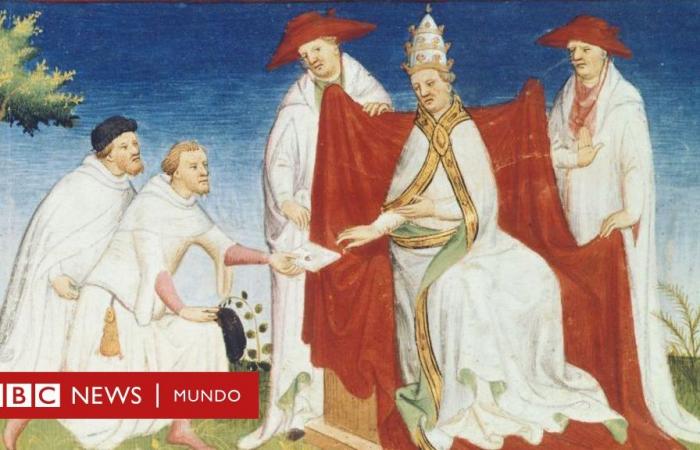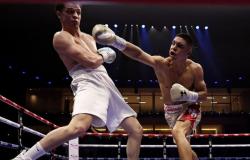Image source, Getty Images
- Author, Guillermo D. Olmo
- Author’s title, BBC News world
-
3 hours
The conclave that will choose the successor of Pope Francis set his basic rules centuries ago.
It was Pope Gregory X who established that the cardinals in charge of choosing the leader of the Catholic Church had to lock themselves and isolate themselves from the outside world to make such a relevant decision.
Although they suffered modifications, the rules that he established are maintained in the essential current.
Although he was not even a priest when they chose him since his pontificate lasted only five years (1271-1276), Gregorio X would become one of the most transcendental potatoes in history.
To understand your life you have to understand your time.
A divided church
In the mid -thirteenth century, Christianity was deeply divided.
Since the eleventh century, European life had been marked by the pulse between the papacy and the empire formed by the King of the Franks Carlomagne mainly in the territories of the current Germany, known today by historians as the sacred Germanic Roman Empire.
“The Pope and the emperor of what we call the Holy Roman Empire Germanic maintained a pulse for the leadership of Christianity,” Alejandro Rodríguez de la Peña, a professor of medieval history at the CEU San Pablo University of Madrid, told BBC world.
“For several centuries the emperors had been faced with the popes to the point that they had come to face militarily and the last great emperor, Federico II, had been excommunicated.”
To those two great powers was added that of a newly unified France and that has completed the conquest of southern Italy to complete “an international panorama that could not be more complex”, in the words of Rodríguez de la Peña.
This was the world when on November 29, 1268 Pope Clemente IV dies in Viterbo, a town part of what were then the pontifical states, which went far beyond the current Vatican.
Following the tradition, the cardinals move to the place where the Pope has died to choose his successor.
Image source, Getty Images
But the cardinals are divided into two sides that reflect the tensions of the moment.
On the one hand, a group of Italian cardinals aligned with the interests of the Empire, known as the Gibelinos; On the other, the French cardinals known as the Güelfos, who oppose that the enormous political, economic and religious power of the Church of the time is under control of the Holy Empire.
The rivalry is such that the months go by without the cardinals managing to agree and no candidate achieves the qualified majority required, so the conclave extends.
It will last almost three years and become the longest in the history of the Church.
Tired of waiting without an outcome, the councilors of the city of Viterbo enclose the cardinals in the palace in which they gathered and even limit the daily food to force them to reach an agreement.
Image source, Getty Images
A “minor character”
Finally, the chosen turns out to be Teobaldo Visconti, a archdiácono who has not even been ordered priest and is at that time in San Juan de Acre, in the current Syria, in the crusade against the Muslims.
“Why they chose a minor character who was also in the other corner of the world is a mystery that we cannot reveal with the available sources,” says Rodríguez de la Peña.
Visconti was an Italian who had not received priestly orders, but who had met and worked with many French cardinals in different positions and who had very good contacts, “so we can speculate that it was perhaps chosen as a commitment candidate,” says the Spanish historian.
The interregno in the Church did not close immediately, since Visconti took months to return from the Holy Land and had to be ordered priest and appointed bishop of Rome before being crowned potato.
But, once on the throne of San Pedro, “Gregorio X showed that he was going to be an independent Pope, who was not going to be pressured and he ended up being a good papacy,” Rodríguez de la Peña values.
The new Pope will try to heal the internal wounds of the Church, seeks understanding with the Orthodox Church and underlines the importance of completing the Crusade with the reconquest of “Holy Land”.
But your most important legacy will be another.
A stricter system
Gregorio X tries to affirm the independence of the Church against the “earthly powers” with the bull Where the riskpromulgated in the council of Lyon of 1274.
Rodríguez de la Peña explains that “La Bula seeks to isolate the voters of the pernicious influences from abroad and the pressures of the rulers” of the time, interested in controlling such a powerful institution in the medieval world as that of the papacy.
Image source, Getty Images
The bull established that the cardinals had to remain guarded and incommunicado in the palace in which the Pope died and, except for disease, could only abandon him once his had chosen a successor.
They had to live in common, only separated by fabrics while the conclave lasted, and from the third day they would only be allowed a daily food dish.
From the eighth they could only eat bread and water.
The provisions hardened the life of the cardinals while the conclave lasted in an apparent attempt of Gregorio for promoting an agreement and preventing the circumstances in which their own choice occurred.
Although Rodríguez de la Peña also appreciates a theological dimension: “The idea is that the isolation and absence of external pressures of the powers of the time allows them to listen to the voice of the Holy Spirit and make a good decision inspired by him.”
Gregorio X died in 1278 and was beatified in 1713.
Some of its most severe provisions for the choice of a new Pope were softened by later pontiffs and others fell into disuse, but the essential idea of the isolation of the voters has remained until now and will show again in the conclave that will choose the successor of Pope Francis.
Subscribe here To our new newsletter to receive every Friday a selection of our best content of the week.
And remember that you can receive notifications in our app. Download the latest version and act.






